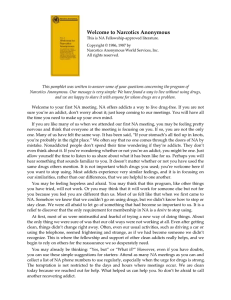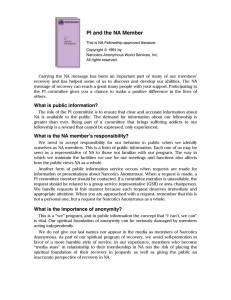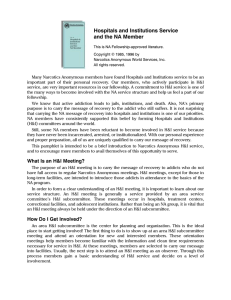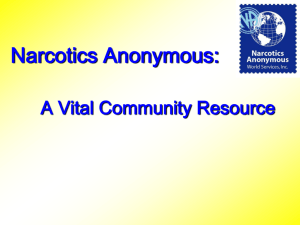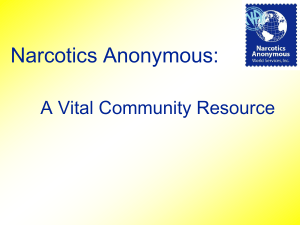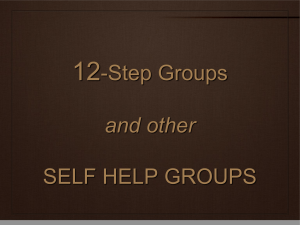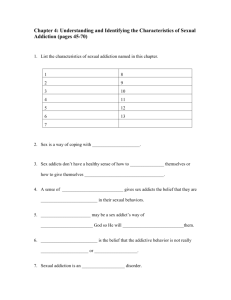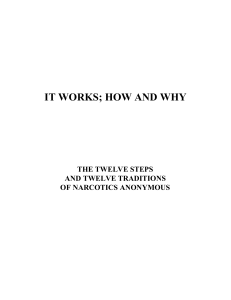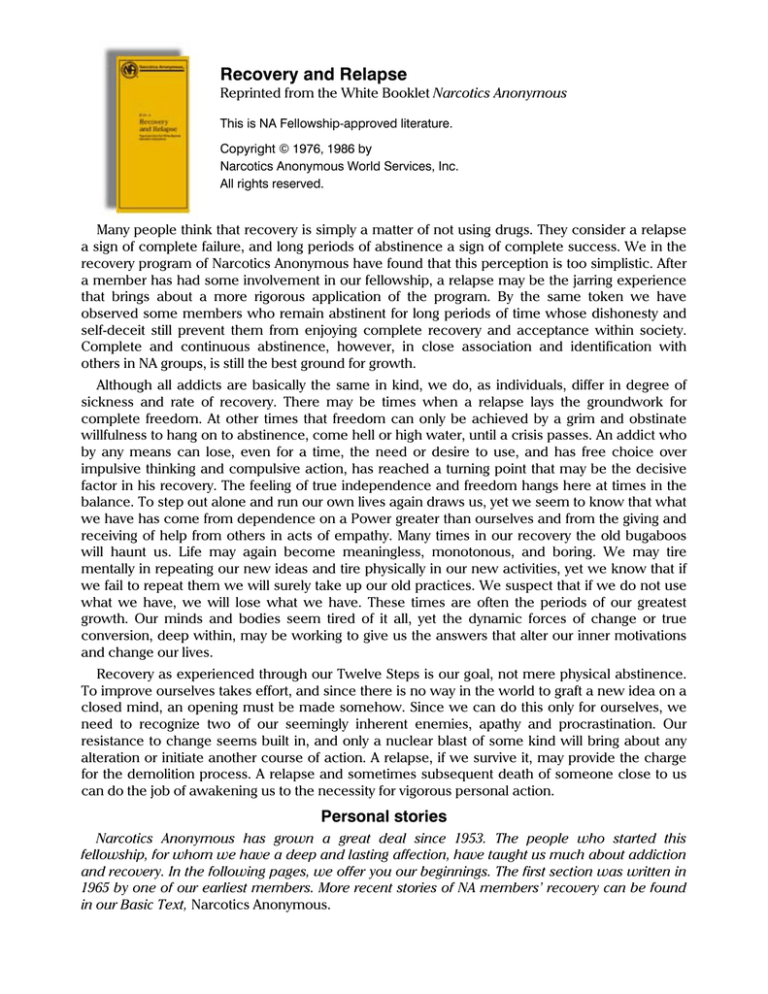
Recovery and Relapse
Reprinted from the White Booklet Narcotics Anonymous
This is NA Fellowship-approved literature.
Copyright © 1976, 1986 by
Narcotics Anonymous World Services, Inc.
All rights reserved.
Many people think that recovery is simply a matter of not using drugs. They consider a relapse
a sign of complete failure, and long periods of abstinence a sign of complete success. We in the
recovery program of Narcotics Anonymous have found that this perception is too simplistic. After
a member has had some involvement in our fellowship, a relapse may be the jarring experience
that brings about a more rigorous application of the program. By the same token we have
observed some members who remain abstinent for long periods of time whose dishonesty and
self-deceit still prevent them from enjoying complete recovery and acceptance within society.
Complete and continuous abstinence, however, in close association and identification with
others in NA groups, is still the best ground for growth.
Although all addicts are basically the same in kind, we do, as individuals, differ in degree of
sickness and rate of recovery. There may be times when a relapse lays the groundwork for
complete freedom. At other times that freedom can only be achieved by a grim and obstinate
willfulness to hang on to abstinence, come hell or high water, until a crisis passes. An addict who
by any means can lose, even for a time, the need or desire to use, and has free choice over
impulsive thinking and compulsive action, has reached a turning point that may be the decisive
factor in his recovery. The feeling of true independence and freedom hangs here at times in the
balance. To step out alone and run our own lives again draws us, yet we seem to know that what
we have has come from dependence on a Power greater than ourselves and from the giving and
receiving of help from others in acts of empathy. Many times in our recovery the old bugaboos
will haunt us. Life may again become meaningless, monotonous, and boring. We may tire
mentally in repeating our new ideas and tire physically in our new activities, yet we know that if
we fail to repeat them we will surely take up our old practices. We suspect that if we do not use
what we have, we will lose what we have. These times are often the periods of our greatest
growth. Our minds and bodies seem tired of it all, yet the dynamic forces of change or true
conversion, deep within, may be working to give us the answers that alter our inner motivations
and change our lives.
Recovery as experienced through our Twelve Steps is our goal, not mere physical abstinence.
To improve ourselves takes effort, and since there is no way in the world to graft a new idea on a
closed mind, an opening must be made somehow. Since we can do this only for ourselves, we
need to recognize two of our seemingly inherent enemies, apathy and procrastination. Our
resistance to change seems built in, and only a nuclear blast of some kind will bring about any
alteration or initiate another course of action. A relapse, if we survive it, may provide the charge
for the demolition process. A relapse and sometimes subsequent death of someone close to us
can do the job of awakening us to the necessity for vigorous personal action.
Personal stories
Narcotics Anonymous has grown a great deal since 1953. The people who started this
fellowship, for whom we have a deep and lasting affection, have taught us much about addiction
and recovery. In the following pages, we offer you our beginnings. The first section was written in
1965 by one of our earliest members. More recent stories of NA members’ recovery can be found
in our Basic Text, Narcotics Anonymous.
We do recover
Although “Politics makes strange bedfellows,” as the old saying goes, addiction makes us one
of a kind. Our personal stories may vary in individual pattern but, in the end, we all have the same
thing in common. This common illness or disorder is addiction. We know well the two things that
make up true addiction: obsession and compulsion. Obsession—that fixed idea that takes us
back, time and time again, to our particular drug, or some substitute, to recapture the ease and
comfort we once knew.
Compulsion—once having started the process with one fix, one pill, or one drink, we cannot
stop through our own power of will. Because of our physical sensitivity to drugs, we are
completely in the grip of a destructive power greater than ourselves.
When, at the end of the road, we find that we can no longer function as human beings, either
with or without drugs, we all face the same dilemma. What is there left to do? There seems to be
this alternative: either go on as best we can to the bitter ends—jails, institutions, or death—or find
a new way to live. In years gone by, very few addicts ever had this last choice. Those who are
addicted today are more fortunate. For the first time in man’s entire history, a simple way has
been proving itself in the lives of many addicts. It is available to us all. This is a simple spiritual,
not religious, program known as Narcotics Anonymous.
When my addiction brought me to the point of complete powerlessness, uselessness, and
surrender some fifteen years ago1, there was no NA. I found AA, and in that fellowship met
addicts who had also found that program to be the answer to their problem. However, we knew
that many were still going down the road of disillusion, degradation, and death because they
were unable to identify with the alcoholic in AA. Their identification was at the level of apparent
symptoms and not at the deeper level of emotions or feelings, where empathy becomes a healing
therapy for all addicted people. With several other addicts and some members of AA who had
great faith in us and the program, we formed, in July of 1953, what we now know as Narcotics
Anonymous. We felt that, now, the addict would find, from the start, as much identification as
each needed to convince himself that he could stay clean by the example of others who had
recovered for many years.
That this was what was principally needed has proved itself in these passing years. That
wordless language of recognition, belief, and faith which we call empathy created the
atmosphere in which we could feel time, touch reality, and recognize spiritual values long lost to
many of us. In our program of recovery, we are growing in numbers and strength. Never before
have so many clean addicts, of their own choice and in free society, been able to meet where
they please, to maintain their recovery in complete creative freedom.
Even addicts said it could not be done the way we had it planned. We believed in openly
scheduled meetings—no more hiding as other groups had tried. We believed this differed from
all other methods tried before by those who advocated long withdrawal from society. We felt that
the sooner the addict could face his problem in everyday living, just that much faster would he
become a real, productive citizen. We eventually have to stand on our own feet and face life on
its own terms, so why not from the start?
Because of this, of course, many relapsed, and many were lost completely. However, many
stayed, and some came back after their setback. The brighter part is the fact that, of those who
are now our members, many have long terms of complete abstinence and are better able to help
the newcomer. Their attitude, based on the spiritual values of our steps and traditions, is the
dynamic force that is bringing increase and unity to our program. Now, we know that the time
has come when that tired old lie, “Once an addict, always an addict,” will no longer be tolerated
by either society or the addict himself. We do recover.
1
Written in 1965.

